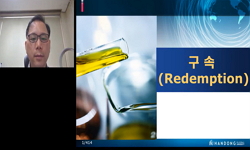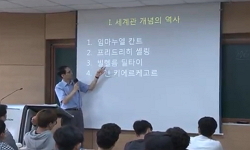본 논문은 기독교 세계관에서 말하는 “문화명령”(culture mandate, Creation Commendment)과 그것에 따른 첫 번째 문화 활동으로 제시되는 아담의 이름 짓기 행위를 말하는 본문인 창세기 1장 26-28절...
http://chineseinput.net/에서 pinyin(병음)방식으로 중국어를 변환할 수 있습니다.
변환된 중국어를 복사하여 사용하시면 됩니다.
- 中文 을 입력하시려면 zhongwen을 입력하시고 space를누르시면됩니다.
- 北京 을 입력하시려면 beijing을 입력하시고 space를 누르시면 됩니다.

“아담의 이름 짓기”는 과연 문화 활동인가?: 문화명령과 관련된 두 개의 텍스트(창 1: 26-28, 2:19) 에 대한 구약신학적 재고찰 = Is “Naming of Adam” a cultural activity?: A Old Testament Theological Study on Two texts(Gen. 1:26- 28, 2:19) related to “cultural mandate”
한글로보기https://www.riss.kr/link?id=A107989789
- 저자
- 발행기관
- 학술지명
- 권호사항
-
발행연도
2021
-
작성언어
-
-
주제어
기독교 세계관 ; 문화명령 ; 아담의 이름 짓기 ; 엘렝틱스 ; 젠더 ; 에제르 케네그도 ; Christian Worldview ; Culture Mandate ; Adam’s naming ; Elenctics ; Gender ; Ezer Kenegdo
-
등재정보
KCI등재후보
-
자료형태
학술저널
-
수록면
201-243(43쪽)
- DOI식별코드
- 제공처
- 소장기관
-
0
상세조회 -
0
다운로드
부가정보
국문 초록 (Abstract)
본 논문은 기독교 세계관에서 말하는 “문화명령”(culture mandate, Creation Commendment)과 그것에 따른 첫 번째 문화 활동으로 제시되는 아담의 이름 짓기 행위를 말하는 본문인 창세기 1장 26-28절과 2장 19-20절을 구약신학적으로 재고찰 한다. 왜냐하면, 이 본문들에 대해 곧 바로 “문화명령”, “문화 행위”라는 철학적인 용어로 명명하기에는 녹녹치 않은 면이 있기 때문이다. 성경 해석에서도 독자반응비평이 발전되면서 저자와 본문 그리고 첫 번째 독자의 이해를 제대로 인지하지 못한 채, 곧바로 두 번째 독자가 자신의 시대에 맞춰 해석하고 적용하는 사례가 빈번하여 본문의 원래적 의미와 차이를 보일 수 있기 때문에, 첫 번째 독자에게 본문의 의미가 무엇이었는지를 고찰하는 것은 중요하다.
이를 위해 먼저, 텍스트 언어학(texts linguistics)과 주석학(exegesis)적인 방법론을 통해 해당 본문들을 “문맥적 정황”에서 의미를 고찰하고, 그 후 에 저자와 첫 번째 독자들의 “삶의 정황”(sitz im Leben)에서의 의미를 고찰 한다. 이 과정을 통해, “문화명령”에 대한 이해의 교정과 함께 아담의 이름 짓기 행위가 가지는 엘렝틱스(Elenctics)적인 면을 중심으로 하는 신학적 의미에 대한 이해의 교정이 발생할 것인데, 그것은 아담의 이름 짓기 사건은 문화명령과의 연관성에서 해석하는 문화 행위라기보다는, 딱맞게 포개지는 “돕는 배필”(에제르 케네그도)과 그에 따른 여자의 창조 사건과 연관 지 어 해석해야 그 신학적 의미가 명료하게 드러난다는 것이다.
이러한 연구의 결과는 하나님과 이스라엘의 관계, 예수와 교회의 관계까지 확장시켜 적용함으로서, 현재 우리 시대에 화두가 되는 “성”(gender) 문제에 구약신학적 대답까지 제시하여, 결국 철학적 사유를 기반으로 하는 기독교 세계관 운동을 삶에서 실천하려는 신앙 고백 공동체가 성장시키고 열매 맺어야 되는 가장 중요한 근본적인 ‘문화’가 무엇인지 밝히고 있다.
다국어 초록 (Multilingual Abstract)
The purpose of this article is to re-thought Old Testament theologically about “culture mandate” (Creation Commandment) in Genesis 1:26- 28 from Christian worldview and following its first cultural activity that presents Adam’s naming behavior i...
The purpose of this article is to re-thought Old Testament theologically about “culture mandate” (Creation Commandment) in Genesis 1:26- 28 from Christian worldview and following its first cultural activity that presents Adam’s naming behavior in Genesis 2:19-20. This is because it is not easy to call these texts directly with the philosophical terms of “cultural mandate” and “cultural activities”. As criticism of independent responses develops in biblical interpretation, there are frequent cases of interpretation and application of the text according to the age of the second reader without properly recognizing the understanding of the author, the text, and the first reader. As it can be seen, it is important to consider what the text meant to the first reader.
To do this, first, the meaning in the “contextual context”(sitz im Literatur) of the texts is considered through Texts Linguistics and exegesis method, and then the meaning in the “life context”(sitz im Leben) of the author and first readers. Through this process, along with the correction of the understanding of the “cultural mandate”, there will be a correction of the understanding of the theological meaning centered on the Elenctics aspect of Adam’s naming behavior, which is the name of Adam. The theological significance of the building incident is clearly revealed when it is interpreted in relation to the creation incident of the woman and the “helper”(Ezer Kennegdo), which overlaps perfectly, rather than as a cultural act interpreted in connection with the cultural mandate.
The result of this study are extended and applied to the relationship between God and Israel and the relationship between Jesus and the church, providing an Old Testament theological answer to the problem of “gender” that is a hot topic in our time. In the end, it reveals what the most important fundamental 'culture' is which the confession community that seeks to practice the Christian worldview movement based on philosophical thinking in life must grow and bear fruit.
동일학술지(권/호) 다른 논문
-
- 한국기독교철학회
- 김남호 ( Kim Namho )
- 2021
- KCI등재후보
-
닫힌 세계 열린 세계: 팬데믹 시대의 그리스도인과 교회에 대한 고찰
- 한국기독교철학회
- 서혜정 ( Seo Hyejeong )
- 2021
- KCI등재후보
-
- 한국기독교철학회
- 양성만 ( Yang Songman )
- 2021
- KCI등재후보
-
라이프니츠의 세 원리에 근거한 과학의 형이상학적 특성에 관한 연구: 클라크에게 보낸 라이프니츠의 서신을 중심으로
- 한국기독교철학회
- 우호용 ( Woo Hoyong )
- 2021
- KCI등재후보




 KCI
KCI 스콜라
스콜라







